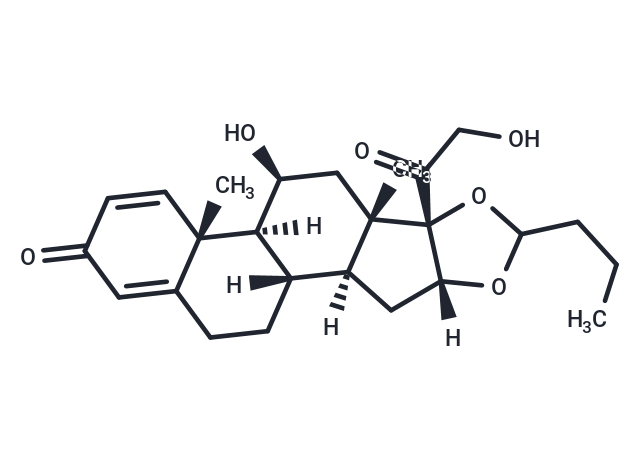Shopping Cart
- Remove All
 Your shopping cart is currently empty
Your shopping cart is currently empty
Budesonide (Pulmicort), an anti-inflammatory corticosteroid, has shown the effective glucocorticoid activitie and few mineralocorticoid activities. According to reports, Budesonide has extensively inhibitory effects against multiple cells types and mediators referred to allergic and nonallergic-mediated inflammatory. What's more, the anti-inflammatory action of budesonide has been revealed to contribute to the effectiveness of asthma.

| Pack Size | Price | Availability | Quantity |
|---|---|---|---|
| 1 mL x 10 mM (in DMSO) | $50 | In Stock |
| Description | Budesonide (Pulmicort), an anti-inflammatory corticosteroid, has shown the effective glucocorticoid activitie and few mineralocorticoid activities. According to reports, Budesonide has extensively inhibitory effects against multiple cells types and mediators referred to allergic and nonallergic-mediated inflammatory. What's more, the anti-inflammatory action of budesonide has been revealed to contribute to the effectiveness of asthma. |
| In vitro | Budesonide effectively inhibits production of eotaxin and RANTES protein although Budesonide inhibits the expression of chemokine mRNA to a variable extent in the human bronchial epithelial cell line BEAS-2B and in primary human bronchial epithelial cells. Budesonide inhibits both RANTES- and eotaxin promoter-driven reporter gene activity in the human bronchial epithelial cell line BEAS-2B and in primary human bronchial epithelial cells. Budesonide also selectively accelerates the decay of eotaxin and MCP-4 mRNA in the human bronchial epithelial cell line BEAS-2B and in primary human bronchial epithelial cells. [1] Budesonide time- and protein synthesis-dependently reduces VEGF secretion and VEGF mRNA expression in both cell types and these effects are inhibited by mifepristone (RU 486), a glucocorticoid receptor antagonist, suggesting that Budesonide reduces VEGF secretion and expression through its glucocorticoid receptor-mediated action. [2] Budesonide causes a dose-dependent, almost total, inhibition of swine dust-induced IL-6 and IL-8 release from epithelial cells and LPS-induced IL-6 and TNF-alpha from alveolar macrophages. [3] |
| In vivo | Budesonide totally prevents the increased production of TNF-alpha, interleukin (IL)-1beta, IL-6, and monocyte chemoattractive protein (MCP)-1 after LPS challenge at both low (2.5 mg/mL/kg) and high (50 mg/mL/kg) concentrations in rats. [4] Budesonide exerts its effects of chemoprevention through growth arrest via Mad2/3 and through apoptosis via Bim/Blk and, by inference, caspase-8/9 in A/J mice. [5] |
| Kinase Assay | Biochemical assays: Recombinant baculoviruses expressing Raf-1 (residues 305–648) and B-Raf (residues 409–765) are purified as fusion proteins. Full-length human MEK-1 is generated by PCR and purified as a fusion protein from Escherichia coli lysates. Sorafenib tosylate is added to a mixture of Raf-1 (80 ng), or B-Raf (80 ng) with MEK-1 (1 μg) in assay buffer [20 mM Tris (pH 8.2), 100 mM NaCl, 5 mM MgCl2, and 0.15% β-mercaptoethanol] at a final concentration of 1% DMSO. The Raf kinase assay (final volume of 50 μL) is initiated by adding 25 μL of 10 μM γ[33P]ATP (400 Ci/mol) and incubated at 32 °C for 25 minutes. Phosphorylated MEK-1 is harvested by filtration onto a phosphocellulose mat, and 1% phosphoric acid is used to wash away unbound radioactivity. After drying by microwave heating, a β-plate counter is used to quantify filter-bound radioactivity. Human VEGFR2 (KDR) kinase domain is expressed and purified from Sf9 lysates. Time-resolved fluorescence energy transfer assays for VEGFR2 are performed in 96-well opaque plates in the time-resolved fluorescence energy transfer format. Final reaction conditions are as follows: 1 to 10 μM ATP, 25 nM poly GT-biotin, 2 nM Europium-labeled phospho (p)-Tyr antibody (PY20), 10 nM APC, 1 to 7 nM cytoplasmic kinase domain in final concentrations of 1% DMSO, 50 mM HEPES (pH 7.5), 10 mM MgCl2, 0.1 mM EDTA, 0.015% Brij-35, 0.1 mg/mL BSA, and 0.1% β-mercaptoethanol. Reaction volumes are 100 μL and are initiated by addition of enzyme. Plates are read at both 615 and 665 nM on a Perkin-Elmer VictorV Multilabel counter at ~1.5 to 2.0 hours after reaction initiation. Signal is calculated as a ratio: (665 nm/615 nM) × 10,000 for each well. For IC50 generation, Sorafenib tosylate is added before the enzyme initiation. A 50-fold stock plate is made with Sorafenib tosylate serially diluted 1:3 in a 50% DMSO/50% distilled water solution. Final Sorafenib tosylate concentrations range from 10 μM to 4.56 nM in 1% DMSO. |
| Synonyms | Rhinocort, Pulmicort, Entocort |
| Molecular Weight | 430.53 |
| Formula | C25H34O6 |
| Cas No. | 51333-22-3 |
| Smiles | C(CO)(=O)[C@]12[C@]3(C)[C@@](C[C@]1(OC(CCC)O2)[H])([C@]4([C@]([C@@H](O)C3)([C@]5(C)C(CC4)=CC(=O)C=C5)[H])[H])[H] |
| Relative Density. | 1.1046 g/cm3 (Estimated) |
| Storage | Powder: -20°C for 3 years | In solvent: -80°C for 1 year | Shipping with blue ice/Shipping at ambient temperature. | |||||||||||||||||||||||||||||||||||
| Solubility Information | DMSO: 40 mg/mL (92.91 mM), Sonication is recommended. Ethanol: 21.5 mg/mL (49.94 mM), Sonication is recommended. | |||||||||||||||||||||||||||||||||||
Solution Preparation Table | ||||||||||||||||||||||||||||||||||||
Ethanol/DMSO
DMSO
| ||||||||||||||||||||||||||||||||||||

Copyright © 2015-2025 TargetMol Chemicals Inc. All Rights Reserved.